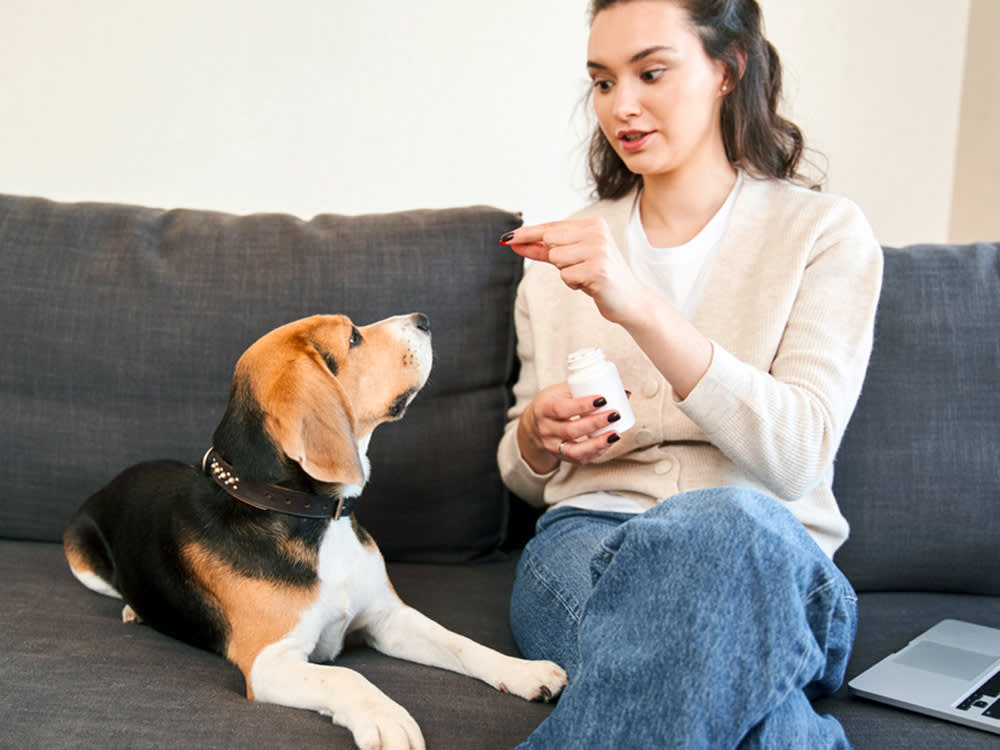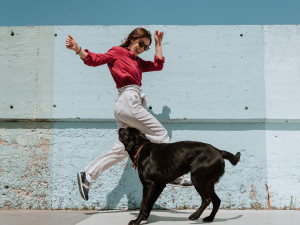How Much Benadryl Can I Give My Dog?
Always, always, always talk to your vet first.
In This Article:
When Can Dogs Take Benadryl? Correct Benadryl Dosage for Dogs Benadryl Formulations for Dogs Weight-Based Dosing Guidelines Risks and Side Effects of Benadryl Checking With Your Veterinarian
Benadryl is an over-the-counter medication available in most pharmacies for the treatment of allergy-related symptoms. While there is a standard adult human dose of this drug, dogs come in very different sizes, so what works for one dog is not always safe or effective for another. Some dogs also have health conditions that could make Benadryl a bad choice for them, so be sure to speak with your vet before giving your dog any medications.
Benadryl is an antihistamine medication commonly used for dogs in the treatment of allergy-related symptoms, but like all medications, it can have side effects or be unsafe if used at the wrong dose or in dogs with certain health problems. For this reason, it is always a good idea to consult with your veterinarian first before giving any medication, even something that is generally considered safe for dogs.
With that in mind, it is good to know what is considered a safe dose for your dog and whether they could safely take Benadryl if they need to. Keeping some on hand as part of your dog’s first aid kit is a good way to be prepared, especially if your dog gets those middle-of-the-night itchies and no one is getting any sleep.
Read on to learn more about when and how to give Benadryl safely to your dog and when you need to seek veterinary care.
How much do you spend on your pet per year?
When can dogs take Benadryl?
Benadryl is an antihistamine medication that is most commonly used in the treatment of allergic reactions; however, it also has some other uses. Histamine is a chemical that is released by the immune system in response to certain allergic and inflammatory triggers. It plays a role in many different symptoms, including hives, swelling, and itchiness. Antihistamines, like Benadryl, block the ability of histamine to bind to its target and therefore should reduce those symptoms.
In dogs, Benadryl is sometimes used for this purpose to treat itchy or swollen skin related to allergic reactions, bee stings, and hives. It’s important to note that for certain allergic conditions, especially chronic allergies and skin disease, Benadryl is not considered as effective in dogs as it is in humans. In these cases, some dogs do not show a significant improvement after taking this medicine.
Benadryl is also used sometimes for other reasons, due to its ability to reduce motion sickness and to cause mild sedation. For dogs who get carsick or experience other forms of motion sickness, Benadryl may help to reduce their nausea. But there are more effective medications for this purpose, which may be necessary in more severe cases. Finally, it does cause a mild sedation in some dogs and for this reason, some pet parents have tried to use it as a sedative.
While it may cause mild sedation for some dogs, it does not consistently have this effect and may not work on every dog. Also, the sedation it causes tends to be very mild, so for dogs that are experiencing more extreme fear or anxiety, it will not be potent enough to help them. In these cases, you will need to consult your vet to get a more appropriate sedative, combined with behavior-modification techniques.
Correct Benadryl dosage for dogs
For some reason, dogs seem to develop incredibly itchy skin in the middle of the night, or they decide to obsessively lick and chew at their paws at top volume, right in the middle of your work video conference. That behavior may have you wondering how much of this medication you can give a dog for itching, chewing, and/or scratching. The first caveat is that Benadryl is not often the most effective treatment for these conditions, especially depending on the cause.
For example, if your dog is scratching due to fleas, skin mites, or a hot spot, Benadryl will not give them suitable relief. Even for conditions like chronic allergies, this medication has not proven to be all that effective for many dogs.
It’s so important to get to your vet and get a proper diagnosis in order to treat them effectively, bring them rapid relief, and get everyone back to sleeping well as soon as possible. That said, there are those times when you just can’t get to the vet immediately, or your dog does have an acute allergic reaction to something like a bug bite or bee sting. If you have been given the OK by your vet to use Benadryl in your dog, you may need to give it a try while you make your way to the vet as soon as possible.
Most veterinarians will recommend starting out with a Benadryl dose of one milligram of Benadryl per pound. This means that a 10-pound dog would need 10 milligrams of Benadryl, while a 50-pound dog would need 50 milligrams of Benadryl. Note that veterinarians usually calculate medication dosing on a dog’s lean body weight, which means that for dogs who are overweight, we tend to dose them based on how much they should weigh, not their current weight, to avoid accidental overdose. This dose may be given once a day, or more often depending on your vet’s recommendations but should never be used more than every eight hours.
Benadryl formulations for dogs
Benadryl comes in many different formulations, and it is very important to carefully study the label and ingredients to choose one that is safe and appropriate for dogs. First, be sure that the medication you purchase contains only diphenhydramine as the active ingredient. This is the generic name for Benadryl. Some formulations may contain other medications for allergy relief, fever reduction, or other symptoms, and many of these other drugs are potentially toxic to dogs, including acetaminophen and pseudoephedrine.
Additionally, some formulations may be alcohol-based or contain xylitol, an artificial sweetener, both of which are toxic to dogs. Once you have found a safe formulation of plain old diphenhydramine, you’ll need to look at the concentration of the medication. This tells you how many milligrams are in a given dose.
For liquid formulations, this will be described as the milligrams per milliliter or milligrams per tablespoon, while pills or capsules will tell you the total milligrams per pill. The typical tablet for adults is a 25 milligram or 50 milligram tablet.
Depending on your dog’s size and dose, you may need to split the tablet into a smaller piece to give them an appropriate dose for their size. If you plan to use a liquid formulation, you will be able to be more precise about the dose if you use an oral syringe, which you may be able to get from your veterinarian. If you are unsure of the proper dose, be sure to speak with your vet to double check your math and ensure you give your dog a safe amount of Benadryl.
Weight-based dosing guidelines
Because dogs come in such a wide range of shapes and sizes, it’s very important to calculate your dog’s specific dose based on their weight. A Chihuahua can easily be 10 times smaller than a Great Dane so it would not be safe to use the same amount of medication on dogs of such different sizes. If too much medication is given to a dog, it can result in an overdose, which may range from mild to serious side effects and can even be life-threatening in extreme cases.
For this reason, doses are always calculated based on a dog’s specific weight. This is why we use the formula of one milligram per pound of body weight. Using this formula, a 10-pound dog would need 10 milligrams of Benadryl while a 50-pound dog would need 50 milligrams of Benadryl. In some situations, a veterinarian may recommend a slightly different dose for a specific purpose, but as a general rule, this is a safe starting point for most dogs.
Be sure to check in with your vet before giving this or any medication to confirm if it is safe and what the appropriate dose. Even doses that are generally considered safe may not be safe for dogs with certain underlying health problems or if they are taking other medications that could interact in a dangerous way.
Risks and side effects of Benadryl
Like any medication, Benadryl can have unwanted side effects as well as risks of complications in certain dogs. The good news is that Benadryl is used often in veterinary medicine and for most dogs, they tolerate it quite well. The bad news is that it doesn’t always work all that well to relieve their symptoms. When it comes to potential risks and side effects, here are the big ones to be aware of:
Sedation: For many dogs, Benadryl causes a mild sedation. Your dog may be extra sleepy after taking Benadryl or may even be wobbly when walking around or mildly disoriented. For this reason, some pet parents intentionally use it as a mild sedative, however, these effects are not consistent and reliable and some dogs will not be sedated at all. A small number of dogs may actually experience the opposite effect and show signs of excitation.
Digestive upset: For some dogs, especially those that need to take Benadryl more often, this medication may cause digestive upset including loss of appetite, nausea, vomiting, diarrhea, or constipation.
Behavioral changes: Some dogs may experience agitation, hyperactivity, and/or increased vocalizations after taking Benadryl.
Rare complications: Other side effects which are much less common include risk of seizure, dry eye, or urinary retention.
Drug interactions: Benadryl may cause complications when combined with certain medications. If your dog already takes other medications, be sure to speak with your vet about possible drug interactions beforehand.
Pre-existing health problems: Due to possible side effects of Benadryl, it may be more risky to give to a dog with certain health problems. This includes dogs that already have urinary problems and have difficulty urinating, dogs with eye problems like glaucoma or dry-eye, and dogs with existing seizure disorders. If your dog has an ongoing medical problem, be sure to consult with your vet before giving Benadryl or any other medications.
Overdose: An overdose can happen when a dog is given too much medication for their size or even sometimes happens when a dog sneaks into the medicine and eats a large amount. If you have any reason to think your dog ingested more than their safe dose of a medication, contact your veterinarian and a pet-poison hotline right away. Early intervention can prevent more serious complications.
Checking with your veterinarian
It’s worth reiterating that you should always check with your veterinarian first before giving any medication. You should also give them a call if you’re worried about your dog’s reaction to this med or any other. Some important questions to ask your vet include how often you can administer Benadryl, confirm the safe dose, and discuss any risks of drug interactions with your dog’s current medications, and/or complications from underlying health problems.
While there are general guidelines here regarding dosage and indications for using Benadryl, your vet will be able to provide more specific information that is appropriate to your dog’s condition and any other complicating factors. In some cases, your vet may recommend a different dose, or even a different medication that may be more effective, safe, and/or appropriate, given your dog’s particular needs.
For dogs who are showing signs of a serious allergic reaction, known as anaphylaxis, which includes swelling of the face, difficulty breathing, vomiting, diarrhea, and/or collapse, they need to be seen immediately at an emergency clinic. Giving them Benadryl at home in these cases is not going to be sufficient to stop the reaction, and you don’t want to waste precious time trying to medicate your dog at home while they potentially get worse.
FAQs (People also ask):
How much Benadryl can I give my dog for itching?
Your dog’s dose will be based on their specific weight. Always check with your vet first, as underlying conditions and other medications may also influence the appropriate dose.
Does Benadryl make dogs sleepy?
It does make some dogs sleepy, I but this can be inconsistent and a small subset of dogs may actually become agitated or excited after taking Benadryl.
How often can I give my dog Benadryl?
This depends on your dog’s condition and your vet’s recommendation. It should never be given more than three times a day, or every eight hours.
What can I give my dog as an alternative to Benadryl?
There are many other medications that may be more effective for a particular condition such as allergies, for sedation, or for motion sickness, so speak with your vet about alternatives that will be best for your dog.
















